1st Infantry Division (United States)
The 1st Infantry Division is a combined arms division of the United States Army, and is the oldest continuously serving in the Regular Army.[3] It has seen continuous service since its organization in 1917 during World War I.[4] It was officially nicknamed "The Big Red One" (abbreviated "BRO"[2]) after its shoulder patch[4] and is also nicknamed "The Fighting First".[4] However, the division has also received troop monikers of "The Big Dead One" and "The Bloody First" as puns on the respective officially-sanctioned nicknames.[5] It is currently based at Fort Riley, Kansas.
World War I
The First Expeditionary Division, later designated the 1st Infantry Division, was constituted on 24 May 1917, in the Regular Army, and was organized on 8 June 1917, at Fort Jay, on Governors Island in New York harbor under the command of Brigadier General William L. Sibert, from Army units then in service on the U.S.-Mexico border and at various Army posts throughout the United States. The original table of organization and equipment (TO&E) included two organic infantry brigades of two infantry regiments each, one engineer battalion; one signal battalion; one trench mortar battery; one field artillery brigade of three field artillery regiments; one air squadron; and a full division train. The total authorized strength of this TO&E was 18,919 officers and enlisted men. George S. Patton, who served as the first headquarters commandant for the American Expeditionary Forces oversaw much of the arrangements for the movement of the 1st Division to France, and their organization in-country. Frank W. Coe, who later served as Chief of Coast Artillery, was the division's first chief of staff.
The first units sailed from New York City and Hoboken, New Jersey on 14 June 1917.[6] Throughout the remainder of the year, the rest of the division followed, landing at St. Nazaire, France, and Liverpool, England. After a brief stay in rest camps, the troops in England proceeded to France, landing at Le Havre. The last unit arrived in St. Nazaire 22 December. Upon arrival in France, the division, less its artillery, was assembled in the First (Gondrecourt) training area, and the artillery was at Le Valdahon.
On 4 July (Independence Day in the United States), the 2nd Battalion, 16th Infantry,[7] paraded through the streets of Paris to bolster the sagging French spirits. At Lafayette's tomb, one of General John J. Pershing's staff said, "Lafayette, we are here!" Two days later, 6 July, Headquarters, First Expeditionary Division was redesignated as Headquarters, First Division.
On 8 August 1917, the 1st Division adopted the Square Table of Organization and Equipment, which included two organic infantry brigades of two infantry regiments each; one engineer regiment; one signal battalion; one machine gun battalion; one field artillery brigade of three field artillery regiments, and a complete division train. The total authorized strength of this new TO&E was 27,120 officers and enlisted men.
On the morning of 23 October, the first American shell of the war was fired toward German lines by a First Division artillery unit. Two days later, the 2nd Battalion of the 16th Infantry suffered the first American casualties of the war.
By April 1918, the Germans had pushed to within 40 miles (64 km) of Paris. In reaction to this thrust, the Big Red One moved into the Picardy Sector to bolster the exhausted French First Army. To the division's front lay the small village of Cantigny, situated on the high ground overlooking a forested countryside. The 28th Infantry Regiment[8] attacked the town, and within 45 minutes captured it along with 250 German soldiers. It was the first American victory of the war. The 28th was thereafter named the "Black Lions of Cantigny."[8]
Soissons was taken by the First Division in July 1918. The Soissons victory was costly – 700 men were killed or wounded. (One of them, Private Francis Lupo of Cincinnati, was missing in action for 85 years, until his remains were discovered on the former battlefield in 2003).[9] The First Infantry helped to clear the St. Mihiel salient by fighting continuously from 11 to 13 September 1918. The last major World War I battle was fought in the Meuse-Argonne Forest. The division advanced seven kilometers and defeated, in whole or part, eight German divisions. This victory was mainly due to the efforts of George C. Marshall, who at the time was a captain in the 1st Division and organized soldier's movements and logistics. The war was over when the Armistice was signed. The division was at Sedan, the farthest American penetration of the war, and was the first to cross the Rhine into occupied Germany.
By the end of the war, the division had suffered 4,964 killed in action, 17,201 wounded in action, and 1,056 missing or died of wounds. Five division soldiers received Medals of Honor.
The division's dog-mascot was a mixed breed terrier known as Rags. Rags was adopted by the division in 1918 and remained its mascot until his death in 1936.[10] Rags achieved notoriety and celebrity as a war dog, after saving many lives in the crucial Argonne Campaign by delivering a vital message despite being bombed and gassed.
Order of battle
Assigned
1st Infantry Brigade
- 16th Infantry
- 18th Infantry
- 2nd Machine Gun Battalion
2nd Infantry Brigade
- 26th Infantry
- 28th Infantry
- 3rd Machine Gun Battalion
1st Field Artillery Brigade
- 5th Field Artillery (155mm)
- 6th Field Artillery (75mm)
- 7th Field Artillery (75mm)
- 1st Trench Mortar Battery
Divisional Troops
- 1st Machine Gun Battalion
- 1st Engineers
- 2nd Field Signal Battalion
- Headquarters Troop
Trains
- 1st Train Headquarters and Military Police
- 1st Ammunition Train
- 1st Supply Train
- 1st Engineer Train
- 1st Sanitary Train (Ambulance Companies and Field Hospitals 2, 3, 12, 13)
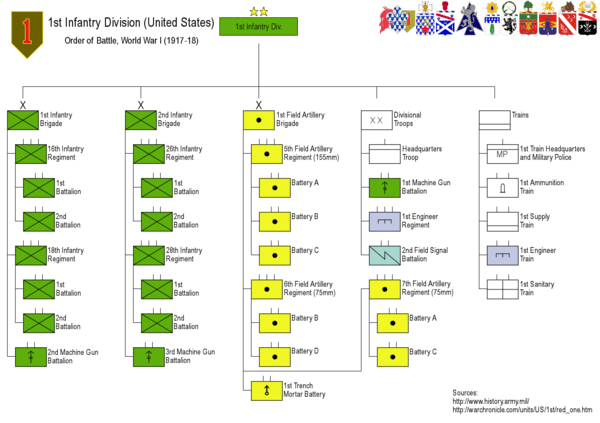
Attached units
En route to France and in 1st (Gondrecourt) Training Area
(as of 9 June – 23 September 1917)
- 5th Regiment USMC
Ménil-la-Tour Area 28 February – 3 April 1918
- 1st Battalion, 2nd Engineers (2nd Division)
Cantingy Sector, at times from 27 April to 7 July 1918
- French 228th Field Artillery Regiment (75 mm)
- French 253d Field Artillery Regiment (75 mm)
- 1st and 2nd Battalions of the French 258th Field Artillery Regiment (75 mm)
- 4th Battalion, Fr 301st Artillery Regiment (155 mm)
- One battery, French 3rd Cl Artillery Regiment (155 mm)
- 3rd and 4th Battalions, French 284th Artillery Regiment (220 mm)
- 2nd Battalion, French 289th Artillery Regiment (220 mm)
- One battery, Fr 3d Cl Artillery Regiment (220 mm)
- 6th Battalion, Fr 289th Artillery Regiment (280 mm)
- Two batteries Fr TM (58 mm)
- One battery Fr TM (150 mm)
- One battery Fr TM (240 mm)
- Fr 5th Tank Battalion (12 tanks)
Aisne-Marne Operation
(as of 18–23 July 1918)
- Fr 42d Aero Sq
- Fr 83d Bln Company
- Fr 253d FA-Portée (75 mm)
- Fr 11th and 12th Groups of Tanks
Saizerais Sector
(as of 8–24 August 1918)
- Fr 258th Aero Sq
- 6th and 7th Bln Companies
- 3 batteries Fr 247th FA- Portée
- Preceding and during the Saint-Mihiel Operation, at times from 8–14 September 1918
- 8th Observation Sq
- 9th Bln Company
- 58th Field Artillery Brigade and 108th Am Tn (33d Division)
- 76th Field Artillery (3d Division) (75 mm)
- Two batteries, 44th CA (8”)
- Troops D, F, and H, 2nd Cavalry
- Two platoons, Company A, 1st Gas Regiment (Eight mortars)
- Two infantry battalions (42nd Division)
- 6th Infantry Brigade (3nd Division)
- Two companies, 51st Pioneer Infantry
- 7th MG Battalion (3d Division)
- 49 tanks of 1st Tank Brigade
Meuse-Argonne Operation
(as of 1–2 October 1918)
- 60th Field Artillery Brigade
- 110th Am Tn (35th Division)
(as of 1–12 October 1918)
- 1st Aero Squadron
- 2d Bln Company
- Fr 219th Field Artillery (75 mm)
- Fr 247th Field Artillery (6 batteries 75 mm)
- Fr 5th Battalion 282d Artillery (220 mm)
- Provisional Squadron, 2d Cavalry
- Company C, 1st Gas Regiment
- Company C, 344th Tank Battalion, 1st Tank Brigade (16 tanks)
- Companies B and C, 345th Tank Battalion, 1st Tank Brigade (16 tanks)
(as of 7 October 1918)
- 362d Infantry (91st Division)
(as of 8–11 October 1918)
- 181st Infantry Brigade (91st Division)
Coblenz Bridgehead
- 14th Bln Company (18–30 June 1919)
- MG elements, Fr 2d Cavalry Division (18–30 June 1919)
- 4th MG Battalion (2d Division) 18–29 June 1919
- 7th MG Battalion (3d Division) 20–30 June 1919
Detached service
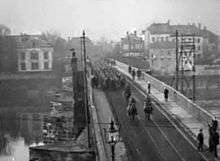
- At Le Valdahon 22 August – 18 October 1917 with 15th (Scottish) Division during the Second Battle of the Aisne, 24 July 1918 with U.S. 90th Division
- 1st Field Artillery Brigade
- 1st Am Tn
- With the 15th (Scottish) Division during Aisne-Marne Operation 24 July 1918 in Saizerais (Villers-en-Haye) Sector 24–28 August 1918;
with 42nd Division in Meuse-Argonne Operation 13–31 October 1918;
with 2nd Division in Meuse-Argonne Operation 1–4 November 1918.- 1st Sn Tn
- With III Corps 28 September – 2 October 1918
- 1st Engineers
- With American forces in Germany after 9 August 1919.
- 2d, 6th Field Artillery
- Company A, 1st Engineers
- Companies A, B, C, D, 1st Sup Tn
- F Hosp 13[11]
Interwar period
The 1st Division returned to the Continental U.S. in September 1919, demobilized its war-time TO&E at Camp Zachary Taylor at Louisville, Kentucky, and then returned to New York, with its headquarters located at Fort Hamilton in Brooklyn.
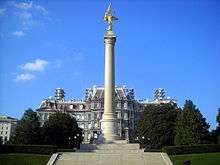
On 7 October 1920, the 1st Division organized under the peacetime TO&E, which included two organic infantry brigades of two infantry regiments each, one engineer regiment; one observation squadron; one field artillery brigade of two field artillery regiments; one medical regiment; one division quartermaster train; and a special troops command replacing the remainder of the division train. The total authorized strength of this TO&E was 19,385. 1st Division was one of three infantry divisions and one cavalry division that was authorized to remain at full peacetime strength. It was the only Regular Army division assigned to the Second Corps Area, which also included the 27th Infantry Division of the New York National Guard; the 44th Infantry Division of the New Jersey, New York, and Delaware National Guards; the 21st Cavalry Division of the New York, Pennsylvania, Rhode Island, and New Jersey National Guards; and the 77th, 78th, and 98th Infantry Divisions and the 61st Cavalry Division of the Organized Reserves. This was the organization that existed in the Second Corps Area for the duration of the Interbellum period.
1st Division adopted a new peacetime TO&E in preparation for war on 8 January 1940, which included three infantry regiments, one military police company, one engineer battalion, one signal company, one light field artillery regiment of three field artillery battalions and one medium field artillery regiment of two field artillery battalions, one medical battalion, and one quartermaster battalion. The authorized strength of this TO&E was 9,057 officers and enlisted men. 1st Infantry Division reorganized again on 1 November 1940 to a new TO&E, which added a reconnaissance troop, and organized the two field artillery regiments into a division artillery command, and beefed up the strength to a total authorized strength of 15,245 officers and enlisted men.
World War II
Combat chronicle
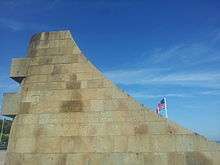
Shortly after the beginning of World War II in Europe, the 1st Division was moved to Fort Benning, Georgia, on 19 November 1939 where it supported the Infantry School as part of American mobilization preparations. It then moved to the Sabine Parish, Louisiana area on 11 May 1940 to participate in the Louisiana Maneuvers. The division next relocated to Fort Hamilton on 5 June 1940, where it spent over six months before moving to Fort Devens, Massachusetts, on 4 February 1941. As part of its training that year, the division participated in both Carolina Maneuvers of October and November before returning to Fort Devens on 6 December 1941.
A day later, on 7 December 1941, the Japanese attacked Pearl Harbor and then the United States declared war. The division was ordered to Camp Blanding, Florida, as quickly as trains could be gathered and winter weather permitted, and arrived on 21 February 1942. The division was there reorganized and refurbished with new equipment, being re-designated as the 1st Infantry Division on 15 May 1942. Within a week, the division was returned to its former post at Fort Benning, from where it was expedited on 21 Jun 1942 to Indiantown Gap Military Reservation for wartime overseas deployment final preparation. The division departed New York Port of Embarkation on 1 August 1942, arrived in Beaminster in south-west England about a week later, and departed 22 October 1942 for the combat amphibious assault of North Africa.[12]:75, 622
As part of II Corps, the division landed in Oran, Algeria on 8 November 1942 as part of Operation Torch, the Allied invasion of French North Africa.[13] The 1st Division commander was Major General Terry de la Mesa Allen and Brigadier General Theodore Roosevelt, Jr. as deputy division commander. Elements then took part in combat at Maktar, Tebourba, Medjez el Bab, the Battle of the Kasserine Pass (where American forces were pushed back), and Gafsa. It then led the allied assault in brutal fighting at El Guettar, Béja, and Mateur. The 1st Infantry Division was in combat in the North African Campaign from 21 January 1943 to 9 May 1943, helping secure Tunisia.

In July 1943, the division took part in Operation Husky invading Sicily still under the command of Major General Allen. Lieutenant General George S. Patton specifically requested the division as part of his forces for the invasion of Sicily. It was assigned to the II Corps. In Sicily the 1st saw heavy action when making amphibious landings opposed by Italian and German tanks at the Amphibious Battle of Gela. The 1st then moved up through the center of Sicily, slogging it out through the mountains along with the 45th Infantry Division. In these mountains, the division saw some of the heaviest fighting in the entire Sicilian campaign at the Battle of Troina; some units losing more than half their strength in assaulting the mountain town. On 7 August 1943, command was assumed by Major General Clarence R. Huebner.
When that campaign was over, the division returned to England 5 November 1943[12]:622 to prepare for the eventual Normandy invasion.[4] The First Infantry Division and one regimental combat team from the 29th Infantry Division comprised the first wave of troops that assaulted German Army defenses on Omaha Beach on D-Day.[4][14] The division had to run 300 yards to get to the bluffs, with some of the division's units suffering 30 percent casualties in the first hour of the assault,[15] and secured Formigny and Caumont in the beachhead by the end of the day. The division followed up the Saint-Lô break-through with an attack on Marigny, 27 July 1944, and then drove across France in a continuous offensive, reaching the German border at Aachen in September. The division laid siege to Aachen, taking the city after a direct assault on 21 October 1944.[4] The First then attacked east of Aachen through the Hurtgen Forest, driving to the Rur, and was moved to a rear area 7 December 1944 for refitting and rest following 6 months of combat. When the German Wacht Am Rhein offensive (commonly called the Battle of the Bulge) was launched on 16 December 1944,[4] the division was quickly moved to the Ardennes front. Fighting continuously from 17 December 1944 to 28 January 1945, the division helped to blunt and reverse the German offensive. Thereupon, the division attacked and again breached the Siegfried Line, fought across the Rur, 23 February 1945, and drove on to the Rhine, crossing at the Remagen bridgehead, 15–16 March. The division broke out of the bridgehead, took part in the encirclement of the Ruhr Pocket, captured Paderborn, pushed through the Harz Mountains, and was in Czechoslovakia, fighting at Kynšperk nad Ohří, Sangerberg, and Mnichov when the war in Europe ended. Sixteen members of the division were awarded the Medal of Honor.
Casualties
- Total battle casualties: 20,659[16]
- Killed in action: 3,616[17]
- Wounded in action: 15,208[18]
- Missing in action: 499[19]
- Prisoner of war: 1,336[20]
Order of battle 1944–1945

HQs & HQs Battery Division Artillery
Headquarters Special Troops
Military Police Platoon
1st Cavalry Recon Squadron
1st CIC Detachment
1st Engineer Combat Battalion
1st Medical Battalion
1st Quartermaster Company
1st Signal Corps Company
5th Field Artillery Battalion (155-MM)
7th Field Artillery Battalion (105-MM)
16th Infantry Regiment
18th Infantry Regiment
26th Infantry Regiment
32nd Field Artillery Battalion (105-MM)
33rd Field Artillery Battalion (105-MM)
701st OD Light Maint Company
745th Tank Battalion – at: 6 June 1944 – 8 May 1945
634th Tank Destroyer Battalion – at: 1 August 1944 – 2 May 1945
635th Tank Destroyer Battalion – at: 7 June 1944 – 30 September 1944
703rd Tank Destroyer Battalion – at: 18 December 1944 – 31 December 1944
103rd AAAA-W Battalion – at: 16 June 1944 – 7 February 1945
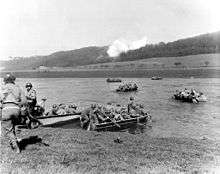
Assignments in European and North African theaters
- 1 February 1943: II Corps, British First Army, 18th Army Group
- July 1943: US II Corps, U.S. Seventh Army, 15th Army Group
- 1 November 1943: US First Army.[note 1]
- 6 November 1943: VII Corps.
- 2 February 1944: V Corps, First Army, British 21st Army Group
- 14 July 1944: US First Army.
- 15 July 1944: VII Corps.
- 1 August 1944: VII Corps, First Army, 12th Army Group.
- 16 December 1944: V Corps.
- 20 December 1944: Attached, with the entire First Army, to the British 21st Army Group.
- 26 January 1945: XVIII Airborne Corps, First Army, 12th Army Group.
- 12 February 1945: III Corps.
- 8 March 1945: VII Corps.
- 27 April 1945: VIII Corps.
- 30 April 1945: V Corps.
- 6 May 1945: United States Third Army, 12th Army Group.
Cold War
Korean War
During the Korean War, the Big Red One was assigned to occupation duty in Germany, while acting as a strategic deterrent against Soviet designs on Europe. 1st Infantry Division troops secured the Nuremberg War Crimes Trials and later transported seven convicted Nazi war criminals to Spandau Prison in Berlin.
In 1955, the division colors left Germany and were relocated to Fort Riley, Kansas.[4]
1950s–1970s
Following its return from Germany, the 1st Infantry Division established headquarters at Fort Riley, Kansas. Its troops reorganized and trained for war at Fort Riley and at other posts. In 1962 and 1963, four 1st Infantry Division Pentomic battle groups (2nd Battle Group, 12th Infantry; 1st Battle Group, 13th Infantry; 1st Battle Group, 28th Infantry; and 2nd Battle Group, 26th Infantry) rotated, in turn, to West Berlin, Germany to augment the U.S. Army's Berlin Brigade during an international crisis initiated by construction of the Berlin Wall. These "Long Thrust Operations" were the most significant deployments conducted by 1st Infantry Division troops during the Cold War, placing Big Red One troops in confrontation with hostile communist forces.
From President Kennedy's approval on 25 May 1961, the Army divisions began to convert to the "Reorganization Objective Army Division 1965" (ROAD) structure in early 1962.[21] While the bulk of the division was stationed at Fort Riley in April 1970 replacing the deactivated 24th Infantry Division, its 3rd Brigade, the Division Forward replacement component of REFORGER for the deactivated 24th Infantry Division, a mixture of cavalry and infantry, was forward-deployed to Germany. The brigade was stationed at Sheridan Kaserne, Augsburg.
Vietnam
The division fought in the Vietnam War from 1965 to 1970.[4] Arriving in July 1965, the division began combat operations within two weeks. By the end of 1965 the division had participated in three major operations: Hump, Bushmaster 1 and Bushmaster II, under the command of MG Jonathan O. Seaman.
In 1966, the division took part in Operation Marauder, Operation Crimp II, and Operation Rolling Stone, all in the early part of the year. In March, Major General William E. DePuy took command.[22] In June and July the division took part in the battles of Ap Tau O, Srok Dong and Minh Thanh Road. In November 1966, the division participated in Operation Attleboro.
1967 saw the division in Operation Cedar Falls, Operation Junction City, Operation Manhattan, and Operation Shenandoah II. MG John H. Hay assumed command in February. On 17 October 1967, the 1st I.D suffered heavy casualties at the Battle of Ong Thanh with 58 killed.
The division involved in the Tet Offensive of 1968, securing the massive Tan Son Nhut Air Base. In March, MG Keith L. Ware took command. That same month the division took part in Operation Quyet Thang ("Resolve to Win") and in April the division participated in the largest operation of the Vietnam War, Operation Toan Thang ("Certain Victory"). On 13 September, the division commander, Maj. Gen. Ware, was killed in action when his command helicopter was shot down by enemy anti-aircraft fire.[23] MG Orwin C. Talbott moved up from his position of assistant division commander to assume command of the division.
In the first half of 1969, The Big Red One conducted reconnaissance-in-force and ambush operations, including a multi-divisional operation, Atlas Wedge. The last part of the year saw the division take part in Dong Tien ("Progress Together") operations. These operations were intended to assist South Vietnamese forces to take a more active role in combat. In August, MG A. E. Milloy took command of the 1st I.D. while the division took part in battles along National Highway 13, known as "Thunder Road" to the end of the year.
In January 1970 it was announced that the division would return to Fort Riley.[4] 11 members of the division were awarded the Medal of Honor. During its involvement in the Vietnam war, the division lost 6,146 killed in action, with a further 16,019 wounded. Twenty of its number were taken as prisoners-of-war.
REFORGER 1988
The division participated in REFORGER 1988 (Return of Forces in Germany), the largest NATO ground maneuver since the end of World War II.[24] The group performed surveillance on the border of Czechoslovakia and Germany during the Cold War.
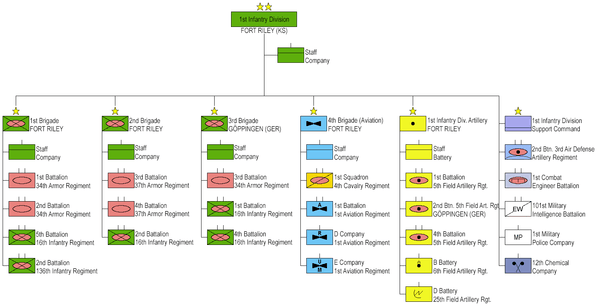
Modern era
First Gulf War
The division, commanded by Major General Thomas G. Rhame, also participated in Operation Desert Storm. The division's two maneuver brigades from Fort Riley were rounded out by the addition of two tank battalions (2nd and 3rd of the 66th Armor Reg.), an infantry battalion (1–41st Infantry Regiment), and a field artillery battalion (4-3 FA) from 2nd Armored Division (Forward) in Germany. Specific combat arms and combat support units of the 3rd Battalion 37th Armored Regiment and others were responsible for the initial breach of the Iraqi defenses providing subsequent passages for the rest of VII Corps, consequently rolling over the Iraqi 26th Infantry Division and taking 2,600 prisoners of war. The division continued with the subsequent 260-kilometre (160 mi) long assault on enemy-held territory over 100 hours, engaging eleven Iraqi divisions, destroying 550 enemy tanks, 480 armored personnel carriers and taking 11,400 prisoners. By the early morning of 28 February 1991, the division had taken position along the "Highway of Death", preventing any Iraqi retreat. The division's HHC, Alpha, Bravo, Charlie and Delta 3/37 Armor, and 1st Squadron, 4th Cavalry Regiment (1/4 CAV), was then tasked with securing town of Safwan, Iraq, and the airfield there where the Iraqis were later forced to sign the surrender agreement.
Valorous Unit citation:
For extraordinary heroism during ground combat operations in Operation Desert Storm from 24 February 1991 through 4 March 1991. Organized as Task Force 3/37th Armor, the Unit was composed of HHC, B, and C Companies, 3/37th Armor; A and D Company, Second Battalion, Sixteenth Infantry; First Platoon of B Company and Second Platoon of C Company, Second Battalion, Third Air Defense Artillery; C Company, First Engineer Battalion; and Ground Surveillance Radar Team B, One Hundred and First Military Intelligence Battalion. As part of the First Infantry Division (Mechanized) and VII Corps main effort, Task Force 3/37th Armor breached the Iraqi defense on 24 February 1991, clearing four passage lanes and expanding the gap under direct enemy fire. The task force then attacked 300 kilometres (190 mi) across southern Iraq into northern Kuwait, severing Iraqi lines of communication, and then drove north once again in the middle of the night (with primitive GPS),into Iraq to assist in the seizure of the airfield at the City of Safwan, Iraq the next morning and the securing of that airfield for the Coalition Forces-Iraqi Cease-Fire negotiations or "peace talks". During the operation, over fifty enemy combat vehicles were destroyed and over 1700 prisoners were captured. Throughout the Ground War, the soldiers performed with marked distinction under difficult and hazardous conditions. Their gallantry, determination, and Esprit de Corps guaranteed victory and maintained the finest traditions of the United States Army.[25]
The Valorous Unit Award[3] is to be awarded to units of the Armed Forces of the United States for extraordinary heroism in action against an armed enemy of the United States while engaged in military operations involving conflict with an opposing foreign force or while serving with friendly foreign forces engaged in an armed conflict against an opposing armed force in which the United States is not a belligerent part for actions occurring on or after 3 August 1963. The Valorous Unit Award requires a lesser degree of gallantry, determination, and esprit de corps than that required for the Presidential Unit Citation. Nevertheless, the unit must have performed with marked distinction under difficult and hazardous conditions in accomplishing its mission so as to set it apart from the other units participating in the same conflict. The degree of heroism required is the same as that which would warrant award of the Silver Star to an individual. Extended periods of combat duty or participation in a large number of operational missions, either ground or air, is not sufficient. This award will normally be earned by units that have participated in single or successive actions covering relatively brief time spans. It is not reasonable to presume that entire units can sustain Silver Star performance for extended time periods under the most unusual circumstances. Only on rare occasions will a unit larger than a battalion qualify for this award.[4] There was also the "bulldozer assault", wherein the 1st and 2nd Brigades from the 1st Infantry Division (Mechanized) used mine plows mounted on tanks and combat earthmovers to bury Iraqi soldiers defending the fortified "Saddam Line." While approximately 2,000 men surrendered, escaping death, one newspaper story reported that U.S. commanders estimated thousands of Iraqi soldiers had been buried alive during the two-day assault over period 24–25 February 1991.[26]
In 1996 the division colors were relocated to the German city of Würzburg.
Balkans
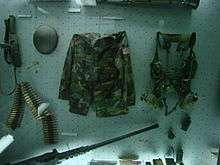
The divisional cavalry squadron, 1st Squadron 4th US Cavalry deployed to Bosnia as part of the initial IFOR mission from January to December 1996. The Squadron was based out of Camp Alicia near the town of Kalesija. 2nd (Dagger) Brigade Combat Team deployed to Bosnia as part of IFOR (and subsequent SFOR) from October 1996 to April 1997. 2nd Brigade was replaced by elements from the 3rd Brigade and the division's aviation brigade. Units from the 1st (Devil) Brigade Combat Team also deployed to Bosnia as part of SFOR6 ("Operation Joint Forge") from August 1999 to April 2000.
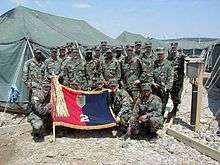
Elements of the division, to include personnel and units from the 2nd, 3rd and aviation brigades, served in Kosovo. During the Kosovo War three soldiers were captured by Serbian forces but were later released after peace talks.
Units of the 1st Infantry Division served in Kosovo as part of the NATO-led Kosovo Force (KFOR) 1A and KFOR 1B from June 1999 to June 2000, then again for KFOR 4A and 4B from May 2002 to July 2003.
Iraq 2003 and 2004
In January 2003, the Division headquarters deployed to Turkey to command and control Army Forces Turkey (ARFOR-T) with a mission to receive and move the 4th Infantry Division across Turkey and into Northern Iraq. The task organization included HHC Division, 1-4 Cavalry, 1-26 Infantry, 1-6 Field Artillery, 2-1 Aviation, HHC Engineer Brigade, 9th Engineers, HHC DISCOM, 701 Main Support Battalion, 601 Aviation Support Battalion, 4-3 Air Defense Artillery, 101 Military Intelligence Battalion, 121 Signal Battalion, 12th Chemical Company, and other US Army Europe units to include the Theater Support Command. The division opened three seaports, two airports, three command posts, and convoy support centers along a 500-mile route from the Turkish coast, through Mardin, to the Northern Iraqi border. When the Turkish government voted to deny US ground forces access to Turkey, ARFOR-T collapsed the line of communication and redeployed to Germany home stations in April 2003.
1–63 Armor of the 3rd Brigade Combat Team deployed to Kirkuk, Iraq from Rose Barracks, Germany, during the first-ever deployment of the USAREUR (United States Army Europe) Immediate Ready Task Force (IRTF) in March 2003, in support of the 173rd Airborne Brigade. The battalion redeployed to Europe with the 173rd in March 2004.
The 1st Brigade, 1st Infantry Division deployed from Fort Riley, Kansas in September 2003 to provide support to the 82nd Airborne Division in the city of Ramadi, Iraq. In September 2004, the 1st Brigade was replaced by elements from the 2nd Infantry Division in Ramadi and redeployed to Ft. Riley.
In January 2004, the Division less the 1st Brigade Combat Team deployed from home stations in Germany to Iraq, where it conducted an area relief with the 4th Infantry Division in the Salah ad-Din, Diyala, Kirkuk and Sulaymaniyah provinces, with the Division headquarters located on Forward Operating Base Danger, in Saddam Hussein's hometown of Tikrit. Task Force Danger, as the division was called during OIF2, was augmented with the 2nd Brigade, 25th Infantry Division, the 30th Heavy Brigade Combat Team of the North Carolina Army National Guard, the 264th Engineer Group of the Wisconsin Army National Guard, the 167th Corps Support Group, and the 2nd Battalion, 108th Infantry Regiment of the New York Army National Guard. The 1st Brigade Combat Team was headquartered in Tikrit, the 3rd Brigade Combat Team was headquartered outside Baqubah, and the 2nd Brigade/25th Infantry Division was headquartered in Kirkuk. The 4th Brigade and Division Support Command were based at Forward Operating Base Spiecher north of Tikrit. Task Force Danger conducted counterinsurgency operations, to include the full spectrum of combat, peace enforcement, training and equipping Iraqi security forces, support to Iraqi institutions to improve quality of life, and two national elections. Major combat included operations in Baqubah, Samarra, Bayji, Najaf, Ad Diwaniyah, and Fallujah. In February 2005, the division facilitated an area relief with the 42d Infantry Division, New York National Guard, and elements of the 3rd Infantry Division and redeployed to home stations in Germany.
Rebasing to US
In July 2006 the division was withdrawn from Germany back to Fort Riley in CONUS, leaving only 2nd (Dagger) Brigade in Schweinfurt, Germany until 28 March 2008 when the 3rd Brigade, 1st Armored Division reflagged as the 2nd Brigade, 1st Infantry Division.
Iraq 2006–2008
The 2nd (Dagger) Brigade Combat Team deployed to Iraq from mid-August 2006 to late November 2007. 1st Battalion, 26th Infantry Regiment was the first to embark and was sent to the Adhamiya district of Baghdad to assist in suppressing the widespread sectarian violence. The 1st Battalion, 77th Armor Regiment was deployed to Ramadi and the 1st Battalion, 18th Infantry Regiment was sent to Forward Operating Base Falcon in the Al Rashid district of southwest Baghdad. HQ and HQ Company 2BCT, 1st ID, 9th Engineer Battalion, 1st Battalion, 7th Field Artillery Regiment, 299th Support Battalion, C/101 MI BN, and 57th Signal Company were all (Dagger) units occupying Camp Liberty, a sprawling encampment of 30,000+ military and DoD civilians located just east of Baghdad International Airport (BIAP). 2BCT MP PLT (formerly 2nd Platoon, 1st Military Police Company) was located at FOB (Forward Operating Base) Justice. During the 15-month deployment, 61 soldiers from the brigade were killed including 31 from 1-26 infantry which had the most casualties in any single battalion since the Vietnam War.
Elements from Fort Riley's 1st (Devil) Brigade deployed in the fall of 2006 to other area of operations in Iraq. Units include companies from the 1st Battalion, 16th Infantry; 1st Battalion, 34th Armor; 1st Battalion, 5th Field Artillery; 1st Engineer Battalion; and D Troop, 4th Cavalry.
Transition team training mission
State-side training for the military transition teams (MiTTs) is located at Fort Riley, Kansas. Training began 1 June 2006. Some of the units such as the 18th Infantry Regiment, the 26th Infantry Regiment, and the 16th Infantry Regiment have already gone into Afghanistan along with some reconnaissance units. Those units have been in the Kunar Province since mid-2006. As of fall 2009 the transition team training mission has moved to Fort Polk, and the 1st Brigade has transitioned into a combat ready force with possible plans to deploy in the next few years.
Iraq 2007

In February 2007, the 4th Infantry Brigade Combat Team deployed to southern Baghdad in support of Operation Iraqi Freedom. the second unit tasked with the "surge" announced earlier in the year by President Bush. The main force of the brigade was under Col "Ricky" Gibbs at FOB Falcon. 2nd Battalion, 16th Infantry was put under operational control of 2nd Brigade, 2nd Infantry Division, and located at FOB Rustamiyah (Featured in the Book "the Good Soldiers" by Washington Post reporter David Finkel)
In the fall of 2007, the Combat Aviation Brigade (Demon Brigade), 1st Infantry Division deployed to Iraq and was placed under the command of Multinational Division – North located at COB Spiecher. The majority of the CAB is stationed at COB Spiecher, with the 1st Squadron, 6th Cavalry Regiment and some supporting elements stationed at FOB Warrior.
Afghanistan 2008–2009
In June and July 2008, 3rd Brigade deployed to Eastern Afghanistan under the command of CJTF-101, relieving the 173rd Airborne Brigade and taking control of the Kunar, Nuristan, Nangarhar, and Laghman provinces. One of the brigades infantry battalions, 2nd Battalion, 2nd Infantry, was tasked out down south in the Kandahar province outside of the brigade command. Main focuses of the brigade and PRT were to protect population centers such as Jalalabad and Asadabad and help develop the local economy through the construction of roads, and provide security while doing so. The brigade returned to Ft. Hood, Texas in July 2009 after a year of combat in which they recorded over 1000 firefights, over 1000 enemy killed, over 500 bombs dropped, 26,000 rounds of artillery fire and over 400 Purple Hearts awarded.
Iraq 2008–2009
In October 2008, the 2nd Heavy Brigade Combat Team deployed to northwest Baghdad in support of Operation Iraqi Freedom. The brigade HQ was located on VBC (Victory Base Complex) and the brigade was responsible for the NW quarter of Baghdad. During this deployment soldiers of the 1st CAB (Combined Arms Battalion), 18th Infantry Regiment were located on FOB Justice. The 1st CAB, 63rd Armor was initially located in Mah-Muh-Diyah (south of Baghdad) and then relocated to JSS Nasir wa Salam (NWS) in the Abu Ghraib area to the west of Baghdad. 5th Squadron, 4th Cavalry was located in the Ghazaliyah area of West Baghdad where they battled the 1920s Revolutionary Brigade and eventually wrested control of the area from them. The 1st Battalion, 7th Field Artillery was located on FOB Prosperity within the "Green Zone", and the 2nd Brigade Special Troops Battalion located in the Victory Base Complex. During this deployment, the 4th Squadron, 10th Cavalry, 2nd Battalion, 8th (US) Cavalry Regiment was attached to the brigade for several months, as well as the 1st Battalion, 41st Field Artillery, and a battalion from the 56th Stryker Brigade Combat Team (PAARNG).
The most notable events which occurred during this time were the Iraqi provincial elections, the expiration of the UN Mandate and the corresponding implementation of the security agreement (SA), between the Government of Iraq and the United States, and "Bloody Wednesday" 19 August 2009 coordinated bombing of the finance ministry and the foreign ministry, with rocket attacks in the green zone. The bombings resulted in 101 dead and over 560 wounded. The Dagger Brigade experienced constant, albeit minor, enemy contact during this deployment—although the brigade still had two KIAs (one serving as the brigade deputy commander's personal security detachment and one from the attached PAARNG battalion) and numerous WIA. During this deployment, LTC J.B. Richardson III (commander of 5–4 CAV) earned a Bronze Star for Valor for single-handedly assaulting through an enemy RKG-3 ambush and inflicting multiple casualties on the enemy.
Iraq 2009–2010
4th Infantry Brigade Combat Team (Dragons) deployed in August 2009 as one of the last combat units to be deployed to Iraq.
Iraq 2010–2011
1st Heavy Brigade Combat Team headquarters with their Brigade Support Battalion (BSB) and Special Troops Battalion deployed to Kirkuk, Iraq in October 2010 to establish the 1-1 Advise and Assist Task Force as part of Operation New Dawn. They were later joined by 1–5 Field Artillery in northern Iraq in late spring 2011.
2nd Heavy Brigade Combat Team deployed to Baghdad, Iraq in November 2010 in an advise and assist role as part of Operation New Dawn under the command of COL Paul T. Calvert. The brigade HQ was located at Victory Base Complex, where it was co-located within the USD-C Division HQ building and shared the same TOC. This unique C2 relationship earned the brigade the moniker of the "Luckiest Brigade in the Army" from the USD-C commander. The brigade was placed under USD-C (initially 1st AD, then 25th Infantry Division after Dec 2011) and was single-handedly responsible for the entire province of Baghdad. As the brigade responsible for the "center of gravity" (i.e. Baghdad) for United States Forces-Iraq, the 2nd "Dagger" Brigade was responsible for advising and assisting 50% of the Iraqi security forces within Iraq to include two Iraqi corps HQ (the Karkh Area Command and Rusafa Area Command) and seven Iraqi divisions (6th IA, 9th IA—Mechanized, 17th IA, 11th IA, 1st FP, 2nd FP, and 4th FP) and 50,000 Iraqi policemen.
The 1st Battalion, 18th Infantry Regiment, commanded by LTC John Cross, was located at Camp Taji and FOB Old MOD. They were partnered with the 9th and 11th IA Divisions. 1st Battalion, 7th FA, commanded by LTC Andrew Gainey, was located at JSS Loyalty. They were partnered with the 1st Federal Police Division. 1st Battalion, 63rd Armored, commanded by LTC Michael Henderson, was located at JSS Deason, Muthana Airfield, and VBC. They were partnered with the 6th and 17th IA Divisions. 5th Squadron, 4th Cavalry, commanded by LTC Mathew Moore was located at JSS Falcon. They were partnered with the 2nd and 4th FP Divisions. The Special Troops Battalion, commanded by LTC Shilisa Geter, was located at VBC (Victory Base Complex) and partnered with the Baghdad Police Directorate. Meanwhile, due to the drawdown of US forces and the redeployment of theater-level sustainment brigades, the 299th BSB, commanded by LTC Dale Farrand, assumed the area support mission for all DOD and DOS elements within the province of Baghdad in addition to supporting the Dagger Brigade.
Significant events during this deployment included the resumption of attacks by the Sadrist movement and other Iranian-backed militia, the subsequent operations that stopped those attacks, the rearward passage of lines of USD-North as they redeployed through Baghdad, the organization and training of divisional field artillery regiments for the IA divisions, the fielding of M1 tanks for the 9th IA Division, and the hand-over of all US facilities within Baghdad to the Government of Iraq or elements of the US State Department. During this deployment the brigade simultaneously trained ISF units to the point of conducting Iraqi-led battalion CALFEXs, advised ISF units as they conducted hundreds of Iraqi-led raids which disrupted the attacks of Iranian-backed militia, while also conducting unilateral and combined force protection operations to ensure the security of US bases and redeploying US forces. The brigade experienced nine KIAs during this deployment, the majority of which resulted from a single IRAM attack (improvised rocket-assisted munition) conducted against JSS Loyalty by Iranian-backed militia on 6 Jun 2011. The brigade departed Iraq in November 2011 after having turned the majority of the city of Baghdad over to complete Iraqi control.
Afghanistan 2011–2012
From 1st Heavy Brigade Combat Team, 1st Battalion, 16th Infantry (CAB) and 4th Squadron, 4th Cavalry deployed to Afghanistan in the winter of 2011, with 2nd Battalion, 34th Armor (CAB) later deploying in the spring of 2011. 1–16 IN (CAB) was assigned to support the combined joint special task force, the Iron Rangers were deployed to 58 remote locations across Afghanistan. They completed more than 10,000 missions as part of village stability operations with the Afghan people. The operations connected the government of Afghanistan to the village level and taught Afghans about their constitution. 2-34 AR (CAB) was deployed to Maiwand District, Kandahar Province located southern Afghanistan near the Kandahar/Helmand Province border.[27] 4-4 Cavalry was deployed to central Zhari District, Kandahar province and conducted thousands of combat patrols throughout the birthplace and homeland of the Taliban.
3rd Infantry Brigade Combat Team deployed to Khost and Paktya provinces in Eastern Afghanistan in January 2011. 2nd Battalion, 2nd Infantry Regiment was once again detached from the brigade and deployed to Ghazni province under Polish command. The brigade conducted Operations Tofan I and II. Tofan I's mission was to disrupt insurgent safe havens in the Musa Khel region of Khowst province, improve the ability for the government to reach the people there and gather intelligence for planning future operations.[28] Tofan II's mission was to establish contact with the insurgents, disrupt their logistics, and reduce any material or moral support from the local population. Movement to the extremely remote area, which featured narrow or non-existent roads set among mountains, included mounted and dismounted soldiers who also had to be aware of the need to control the key terrain features around Suri Kheyl.[29]
Afghanistan 2012–2013
The 1st Infantry Division headquarters deployed to Bagram, Afghanistan on April 19, 2012 as part of Operation Enduring Freedom XIII after receiving responsibility for Regional Command (East)(RC(E)) from 1st Cavalry Division.[30] The division served as the Combined Joint Task Force-1 (CJTF-1) and RC(E), command and controlling the vital region (Bamiyan, Parwan, Panjshayr, Kapisa, Laghman, Nuristan, Konar, Nangarhar, Wardak, Logar, Paktiya, Khowst, Ghazni, and Paktika) surrounding Kabul and a large portion of the volatile border with Pakistan. During the division's tenure in Afghanistan, the division oversaw a transition of authority to the Afghan National Security Forces (ANSF)201st Corps north of Kabul and had prepared the ANSF 203rd Corps to assume full security responsibility south of Kabul prior to transitioning RC(E) to 101st Airborne Division (AASLT).
The 4th IBCT deployed to Afghanistan in May 2012 for a 9-month deployment. The brigade operated in Ghazni and Paktika provinces in eastern Afghanistan.[31] Dragon Brigade concluded its deployment in February 2013, transitioning oversight of Ghazni province to 1st Brigade, 10th Mountain Division and Paktika province to 2nd Brigade, 10th Mountain Division and full security responsibility for those provinces to 3rd and 2nd Brigades, ANSF 203rd Corps, respectively.[32]
Operation Inherent Resolve
In response to the growing ISIL threat the Department of Defense announced on September 25, 2014 that approximately 500 soldiers from 1st Infantry Division Headquarters will be deployed to Iraq with the task of assisting Iraqi Security Forces. This will be the first Division HQ deployed in Iraq since withdrawal back in 2011. Among the soldiers sent over approximately 200 will be stationed in Baghdad, where they will make up close to half of US troops deployed.[33]
In mid-October 2016 the US Army announced it will deploy about 500 soldiers from the 1st Infantry Division Headquarters to Iraq in the fall of 2016. Troops will assume the role of Combined Joint Forces Land Component Command-Iraq in support of Operation Inherent Resolve.[34]
Operation Freedom's Sentinel
In late July 2016, the U.S. Army announced that it will send 800 soldiers from 1st Combat Aviation Brigade, 1st Infantry Division, to Afghanistan to support Operation Freedom's Sentinel- the U.S. counter-terrorism operation against the remnants of al-Qaeda, ISIS–K and other terror groups. The brigade will deploy with its AH-64 Apache attack helicopters and UH-60 Black Hawk utility helicopters sometime before October 2016.[35]
Insignia

No creditable source states how the insignia of the 1st Infantry Division originated in World War I. There are two theories as to how the idea of the patch came about. The first theory states that the 1st Division supply trucks were manufactured in England. To make sure the 1st Division's trucks were not confused with other allies, the drivers would paint a huge "1" on the side of each truck. Later, the division engineers would go even farther and put a red number one on their sleeves.[36]
The second theory claims that a general of the division decided the unit should have a shoulder insignia. He decided to cut a red numeral "1" from his flannel underwear. When he showed his prototype to his men, one lieutenant said, "the general's underwear is showing!" Offended, the general challenged the young lieutenant to come up with something better. So, the young officer cut a piece of gray cloth from the uniform of a captured soldier, and placed the red "1" on top.[36]
Song
Toast of the Army,
Favorite Son! Hail to the brave Big Red One!
Always the first to thirst for a fight.
No foe shall challenge our right to victory.
We take the field, A grand sight to see.
Pride of the Infantry.
Men of a great division,
Courage is our tradition,
Forward the Big Red One!
According to the 1st Infantry Division history, the song was composed in 1943 by Captain Donald T. Kellett, who retired after a 30-year career as a colonel and died in 1991.[37]
Current structure

1st Infantry Division consists of the following elements:
- Division Headquarters and Headquarters Battalion (DHHB)
-
Headquarters and Support Company
-
Operations Company
-
Intelligence and Sustainment Company
-
Division Signal Company
-
1st Infantry Division Band
-
Commanding General's Mounted Color Guard
- 1st Armored Brigade Combat Team (Devil Brigade)[1]
Deployment to South Korea under operational command of 2nd Infantry Division [38]
-
 Headquarters and Headquarters Company
Headquarters and Headquarters Company -
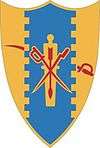 1st Squadron, 4th Cavalry Regiment
1st Squadron, 4th Cavalry Regiment -
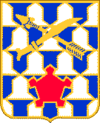 1st Battalion, 16th Infantry Regiment Iron Rangers
1st Battalion, 16th Infantry Regiment Iron Rangers -
 2nd Battalion, 34th Armor Regiment Dreadnaughts
2nd Battalion, 34th Armor Regiment Dreadnaughts -
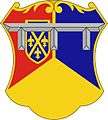 3rd Battalion, 66th Armor Regiment Iron Knights
3rd Battalion, 66th Armor Regiment Iron Knights -
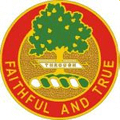 1st Battalion, 5th Field Artillery Regiment Hamilton's Own
1st Battalion, 5th Field Artillery Regiment Hamilton's Own -
 1st Engineer Battalion Diehards
1st Engineer Battalion Diehards -
 101st Brigade Support Battalion Guardians
101st Brigade Support Battalion Guardians
- 2nd Armored Brigade Combat Team (Dagger Brigade)
-
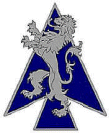 Headquarters and Headquarters Company
Headquarters and Headquarters Company -
 5th Squadron, 4th Cavalry Regiment
5th Squadron, 4th Cavalry Regiment -
 1st Battalion, 18th Infantry Regiment Vanguards
1st Battalion, 18th Infantry Regiment Vanguards -
 1st Battalion, 63rd Armor Regiment Dragons
1st Battalion, 63rd Armor Regiment Dragons -
 2nd Battalion, 70th Armor Regiment Thunder Bolts
2nd Battalion, 70th Armor Regiment Thunder Bolts -
 1st Battalion, 7th Field Artillery Regiment First Lightning
1st Battalion, 7th Field Artillery Regiment First Lightning -
 82nd Brigade Engineer Battalion
82nd Brigade Engineer Battalion -
 299th Brigade Support Battalion Lifeline
299th Brigade Support Battalion Lifeline
- 1st Infantry Division Artillery
-
Headquarters and Headquarters Battery
- Combat Aviation Brigade, 1st Infantry Division (Demon Brigade)
-
Headquarters and Headquarters Company
-
 1st Battalion (Attack), 1st Aviation with 24 AH-64D Apache Longbows
1st Battalion (Attack), 1st Aviation with 24 AH-64D Apache Longbows -
 1st Squadron, 6th Cavalry Regiment with 24 AH-64D and 12 RQ-7 Shadows. The Fighting Sixth
1st Squadron, 6th Cavalry Regiment with 24 AH-64D and 12 RQ-7 Shadows. The Fighting Sixth -
 2nd Battalion (General Support), 1st Aviation Regiment with 8 UH-60L/M Black Hawks, 10 CH-47D Chinooks and 10 HH-60L/M Black Hawks
2nd Battalion (General Support), 1st Aviation Regiment with 8 UH-60L/M Black Hawks, 10 CH-47D Chinooks and 10 HH-60L/M Black Hawks -
 3rd Battalion (Assault), 1st Aviation Regiment with 30 UH-60M Black Hawks
3rd Battalion (Assault), 1st Aviation Regiment with 30 UH-60M Black Hawks -
 601st Aviation Support Battalion
601st Aviation Support Battalion
-
 1st Special Troops Battalion (STB)
1st Special Troops Battalion (STB)
-
 Headquarters and Headquarters Company (HHC)
Headquarters and Headquarters Company (HHC) -
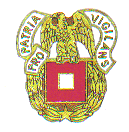 267th Signal Company
267th Signal Company
-
-
 541st Combat Sustainment Support Battalion
541st Combat Sustainment Support Battalion
-
 Headquarters and Headquarters Company
Headquarters and Headquarters Company -
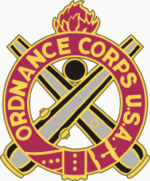 1st Support Maintenance Company
1st Support Maintenance Company -
 24th Composite Truck Company
24th Composite Truck Company -
 165th Movement Control Team
165th Movement Control Team -
 266th Movement Control Team
266th Movement Control Team -
 526th Quartermaster Composite Supply Company
526th Quartermaster Composite Supply Company
-
Awards and decorations
Campaign credit
| Conflict | Streamer | Year(s) |
|---|---|---|
| World War I |
Montdidier-Noyon | 1918 |
| Aisne-Marne | 1918 | |
| St. Mihiel | 1918 | |
| Meuse-Argonne | 1918 | |
| Lorraine 1917 | 1917 | |
| Lorraine 1918 | 1918 | |
| Picardy 1918 | 1918 | |
| World War II |
Algeria-French Morocco (with arrowhead) | 1942 |
| Tunisia | 1942 | |
| Sicily (with arrowhead) | 1943 | |
| Normandy (with arrowhead) | 1944 | |
| Northern France | 1944 | |
| Rhineland | 1945 | |
| Ardennes-Alsace | 1944–1945 | |
| Central Europe | 1945 | |
| Vietnam War |
Defense | 1965 |
| Counteroffensive | 1965–1966 | |
| Counteroffensive, Phase II | 1966–1967 | |
| Counteroffensive, Phase III | 1967–1968 | |
| Tet Counteroffensive | 1968 | |
| Counteroffensive, Phase IV | 1968 | |
| Counteroffensive, Phase V | 1968 | |
| Counteroffensive, Phase VI | 1968–1969 | |
| Tet 69/Counteroffensive | 1969 | |
| Summer-Fall 1969 | 1969 | |
| Winter-Spring 1970 | 1969–1970 | |
| Gulf War |
Defense of Saudi Arabia | 1990–1991 |
| Liberation and Defense of Kuwait | 1991 | |
| Ceasefire | 1991 | |
| Global War On Terrorism |
Global War on Terrorism | 2001–present |
| Operation Iraqi Freedom |
Iraqi Governance | 2004 |
| National Resolution | 2005 | |
| Iraqi Surge | 2007 | |
| Iraqi Sovereignty | 2009 | |
| New Dawn | 2010 | |
| Operation Enduring Freedom |
Transition I | 2011–2012 |
Unit decorations
| Ribbon | Award | Year | Notes |
|---|---|---|---|
| Meritorious Unit Commendation (Army) | VIETNAM 1968 | ||
| Meritorious Unit Commendation (Army) | SOUTHWEST ASIA | ||
| Army Superior Unit Award (Army) | 1997 | ||
| French Croix de Guerre, with Palm | KASSERINE | ||
| French Croix de Guerre, with Palm | NORMANDY | ||
| French Croix de guerre, World War II, Fourragere | |||
| Belgian Fourragere | 1940 | ||
| Cited in the Order of the Day of the Belgian Army | For action at MONS | ||
| Cited in the Order of the Day of the Belgian Army | For action at EUPEN-MALMEDY | ||
| Republic of Vietnam Cross of Gallantry, with Palm | 1965–1968 | For service in Vietnam | |
| Republic of Vietnam Civil Action Unit Citation | 1965–1970 | For service in Vietnam |
See also
- The Big Red One (1980), a movie about the division's experiences in World War II written by Samuel Fuller who served in the division during World War II.
- Cantigny, the former estate of Col. Robert R. McCormick, is where the 1st Infantry Division Museum is located. The museum showcases the history of the 1st Infantry Division, from their involvement in World War I to the present, along with several tanks situated outside the museum dating from World War I to the present.[39]
- Iraq Assistance Group, a former joint command coordinating the coalition military transition team mission in Iraq which was formed from the 1st Infantry Division.
Notes
- ↑ In these tabulations, the army and higher headquarters to which the division is assigned or attached is not repeated when the division is assigned or attached to a different corps in the same army. On 6 November 1943, for example, the 1st Infantry Division was assigned to the VII Corps which was itself assigned to First Army; on 1 August 1944, the 12th Army Group became operational; and on 6 May 1945, the 1st Infantry Division left First Army for the first time during the operations on the Continent for reassignment to the Third Army.
References
![]() This article incorporates public domain material from the United States Army Center of Military History document "1st Infantry Division Honors".
This article incorporates public domain material from the United States Army Center of Military History document "1st Infantry Division Honors".
- 1 2 "Special Unit Designations". United States Army Center of Military History. 21 April 2010. Archived from the original on 9 June 2010. Retrieved 23 June 2010.
- 1 2 Hoff, Stephanie (20 March 2012). "'BRO' Cases Colors, Prepares for Afghanistan". 1st Infantry Division/Fort Riley News. Archived from the original on 3 November 2016. Retrieved November 3, 2016.
- ↑ "1st Infantry Division". GlobalSecurity.org. Archived from the original on 13 August 2008. Retrieved 12 August 2008. The U.S. Army states that the 28th Infantry Division is the oldest division in the Army. "'Keystone Division' celebrates 133rd Birthday". U.S. Army. March 12, 2012.
- 1 2 3 4 5 6 7 8 9 10 "The History of the 1st Infantry Division". U.S. Army.
- ↑ Stanton, Shelby, The Rise and Fall of an American Army, Random House. 2003. p. 326 et al. These troop nicknames applied in World War II as well as Vietnam.
- ↑ Archived 17 June 2008 at the Wayback Machine.
- ↑ 2nd Battalion 16th Infantry on Ft. Riley's web site
- 1 2 "1st Battalion, 28th Infantry Regiment "Black Lions"". GlobalSecurity.org. 17 July 2006. Archived from the original on 15 February 2007. Retrieved 9 February 2007.
- ↑ Baack, Stephen (25 October 2006). "1st Division Soldier identified, laid to rest". U.S. Army. Retrieved 10 September 2012.
- ↑ "Rags (1916–1936) – Find A Grave Memorial". Find A Grave. 1 January 2001. Retrieved 4 October 2007.
- ↑ Order of Battle of the United States Land Forces in the World War, American Expeditionary Forces: Divisions, Volume 2
- 1 2 Stanton, Shelby L. (10 April 2006). World War Two Order of Battle, U.S. Army. Stackpole Books. ISBN 978-0-8117-0157-0. Retrieved 10 September 2012.
- ↑ Anderson, Charles R. Algeria-French Morocco. The U.S. Army Campaigns of World War II. United States Army Center of Military History. CMH Pub 72-11. Retrieved 10 August 2008.
- ↑ "Assault Plan". Omaha Beachhead. Washington, DC: United States Army Center of Military History. 1945. pp. 30–33, 38–39. CMH Pub 100-11. Retrieved 10 June 2007.
- ↑ "Omaha Beachhead". Historical Division, War Department. 20 September 1945. pp. 40, 48–49. Retrieved 10 June 2007.
- ↑ Army Battle Casualties and Nonbattle Deaths (Statistical and Accounting Branch, Office of the Adjutant General, 1 June 1953
- ↑ Army Battle Casualties and Nonbattle Deaths (Statistical and Accounting Branch, Office of the Adjutant General, 1 June 1953
- ↑ Army Battle Casualties and Nonbattle Deaths (Statistical and Accounting Branch, Office of the Adjutant General, 1 June 1953
- ↑ Army Battle Casualties and Nonbattle Deaths (Statistical and Accounting Branch, Office of the Adjutant General, 1 June 1953
- ↑ Army Battle Casualties and Nonbattle Deaths (Statistical and Accounting Branch, Office of the Adjutant General, 1 June 1953
- ↑ Cheng, Christopher C.S., Air Mobility: The Development of a Doctrine, Greenwood Press, 1994, p. 172
- ↑ "South Dakota State University bio". Archived from the original on 11 July 2007. Retrieved 10 July 2007.
- ↑ "World: An Unusual General". Time Magazine. 20 September 1968. Retrieved 10 September 2012.
- ↑ The Stars and Stripes, Vol. 47, No. 147, Sept. 12, 1988
- ↑ "Operations DESERT SHIELD and DESERT STORM: Valorous Unit Award Citations -". U. S. Army Center of Military History, United States Army. Retrieved 7 September 2016.
 This article incorporates text from this source, which is in the public domain.
This article incorporates text from this source, which is in the public domain. - ↑ Col. Moreno, Anthony; PATRICK J. SLOYAN (September 12, 1991). "U.S. Tank-Plows Said to Bury Thousands of Iraqis". Newsday. US Army. Retrieved 22 September 2014.
- ↑
- ↑ "DVIDS - News - TF Duke operation disrupts pre-Ramadan attacks, gains intel". Dvidshub.net. Retrieved 2014-07-21.
- ↑ "Big Red One Soldiers, Afghan forces take on enemy during Operation Tofan II | Article | The United States Army". Army.mil. Retrieved 2014-07-21.
- ↑
- ↑ "Retina scan | Flickr - Photo Sharing!". Flickr. 2012-06-04. Retrieved 2014-07-21.
- ↑ Archived 13 March 2013 at the Wayback Machine.
- ↑ Red One’ Soldiers to deploy to Iraq in advise, assist, enable mission
- ↑ "Army to Deploy 1,700 Paratroopers to Iraq". military.com. 3 November 2016.
- ↑ "Army to Deploy 101st Airborne Soldiers to Afghanistan". military.com. 6 September 2016.
- 1 2 "The Big Red One Patch". Society of the First Infantry Division. Retrieved 19 October 2008.
- ↑ Archived 12 May 2009 at the Wayback Machine.
- ↑ "1BCTDocuments" (PDF). Retrieved 20 April 2010.
deadurl=yes
- ↑ Hannah Marsh, "Memory in World War I American museum exhibits" (MA thesis, Kansas State University, 2015, online)
Further reading
- Felix G. "Third Graders at War" The true story of a Cavalry Scout during Operation Desert Storm ISBN 978-1-4575-0152-4
- Rohan, John Rags, the Dog Who Went to War, Diggory Press, ISBN 978-1-84685-364-7
- Gantter, Raymond Roll Me Over, An Infantryman's World War II, Ivy Books, ISBN 0-8041-1605-9
- Stanton, Shelby, Vietnam Order of Battle: A Complete Illustrated Reference to the U.S. Army and Allied Ground Forces in Vietnam, 1961–1973, Stackpole Books 2006 ISBN 0-8117-0071-2
External links
| Wikimedia Commons has media related to 1st Infantry Division (United States). |
- Official 1st Infantry Division website
- Society of the First Infantry Division
- Duty First: The 1st Infantry Division's award-winning quarterly magazine
- First Division Museum at Cantigny Park
- The First! The Story of the 1st Infantry Division (WWII divisional history booklet, 1945)
- Echoes of War: Stories from the Big Red One Interactive PBS documentary about the 1st Infantry Div.
- 1st Infantry Division Living History Group – Germany
- Cantigny First Division Oral Histories, includes freely accessible video oral history interviews with veterans of the U.S. Army's First Infantry Division
- Media
- The short film Big Picture: The Big Red One is available for free download at the Internet Archive
- The short film "The Fighting First (1946)" is available for free download at the Internet Archive
- The short film STAFF FILM REPORT 66-5A (1966) is available for free download at the Internet Archive
- The short film STAFF FILM REPORT 66-1OA (1966) is available for free download at the Internet Archive
- The short film STAFF FILM REPORT 66-17A (1966) is available for free download at the Internet Archive
- The short film STAFF FILM REPORT 66-21A (1966) is available for free download at the Internet Archive
- The short film STAFF FILM REPORT 66-22A (1966) is available for free download at the Internet Archive
- The short film STAFF FILM REPORT 66-29A (1966) is available for free download at the Internet Archive
- The short film STAFF FILM REPORT 66-30A (1966) is available for free download at the Internet Archive
| Preceded by 34th Division |
Multinational Division South 2010–2011 |
Succeeded by none |
| Preceded by 1st Cavalry Division |
Regional Command East 2012–2013 |
Succeeded by 101st Airborne Division |


